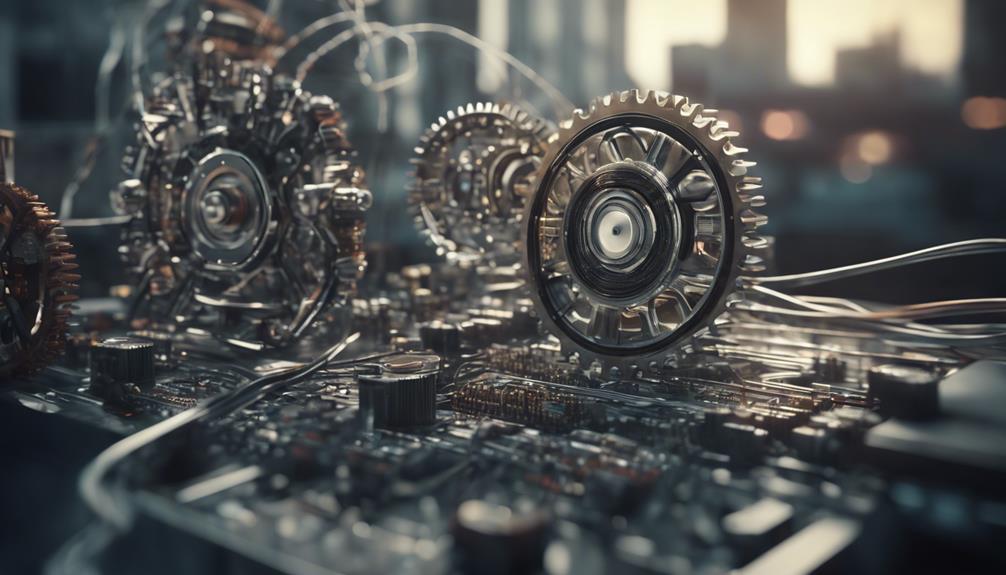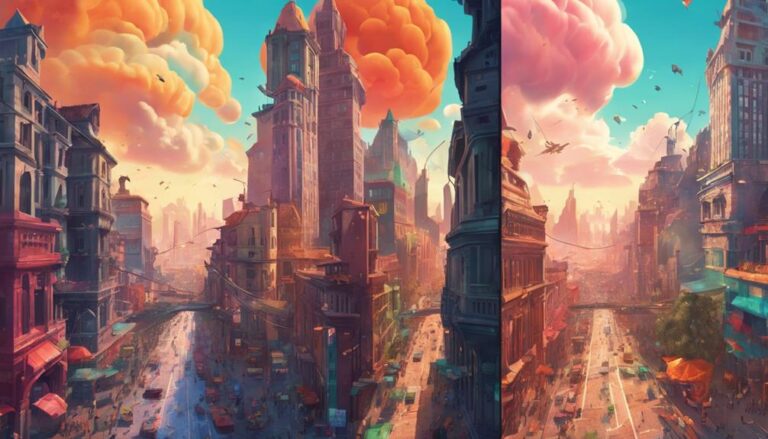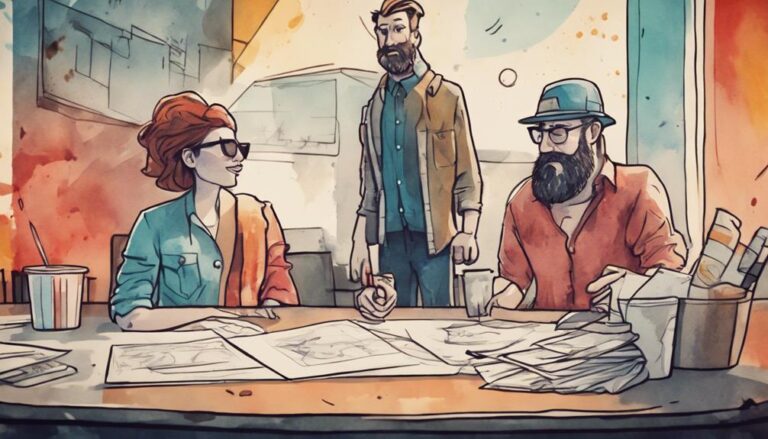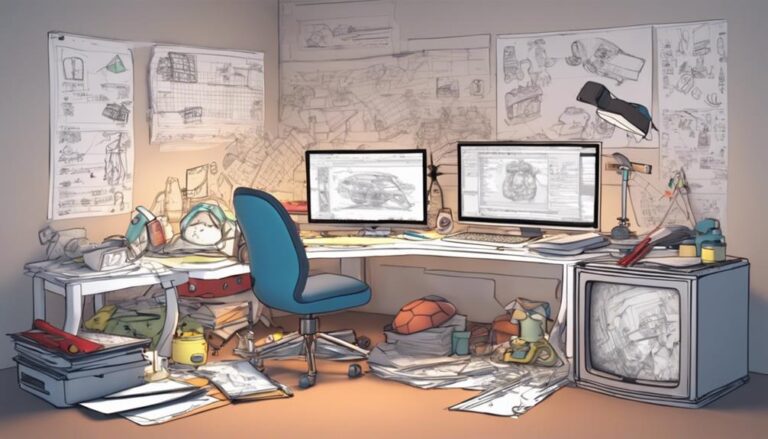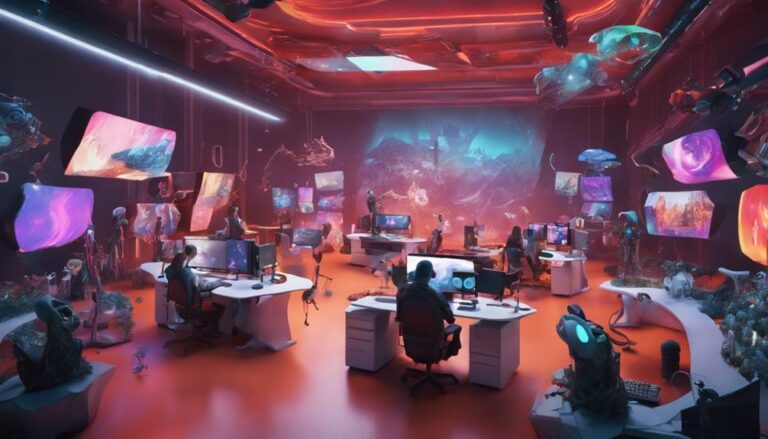Streamlining CGI Animation Video Production Pipelines
As you navigate the complex world of CGI animation video production, you're likely no stranger to the frustrations of inefficient pipelines. You've experienced the bottlenecks, the missed deadlines, and the wasted resources. But what if you could identify the weak links in your pipeline and strengthen them? What if you could simplify your project management, centralize your assets, and automate repetitive tasks, freeing up more time for creativity and innovation? The truth is, streamlining your pipeline is within reach, and the benefits are substantial. But where do you start, and what strategies will have the greatest impact on your studio's productivity and success?
Key Takeaways
- Identify and address pipeline inefficiencies through bottleneck analysis, workflow optimization, and resource allocation to reduce delays and costs.
- Centralize asset management to eliminate data silos, reduce version control issues, and ensure consistency across the production pipeline.
- Automate repetitive tasks and processes using scripts, tools, and plugins to minimize labor costs, increase efficiency, and reduce errors.
- Optimize software toolkits and plugins by leveraging updates, identifying performance bottlenecks, and ensuring seamless integration to improve rendering quality and speed.
Identifying Inefficiencies in Current Pipelines
You likely have experienced inefficiencies in your current CGI animation pipeline, manifesting as bottlenecks, missed deadlines, or wasted resources.
To tackle these issues, vital examination is necessary to conduct a thorough pipeline audit. This involves meticulously examining each stage of your pipeline, from script to final render, to identify areas of inefficiency.
By doing so, you'll be able to pinpoint bottlenecks, which are often the root cause of delays and resource waste.
Bottleneck analysis is a pivotal step in this process.
It involves analyzing the workflow, resource allocation, and task dependencies to identify specific pain points.
This might reveal that a particular task is consistently taking longer than expected, or that a specific team member is overwhelmed with tasks.
By identifying these bottlenecks, you can develop targeted strategies to address them, such as reassigning tasks, optimizing workflows, or investing in new tools.
A thorough pipeline audit and bottleneck analysis will provide a clear understanding of your pipeline's inefficiencies, empowering you to make data-driven decisions to streamline your CGI animation pipeline.
Simplifying Project Management Structures
When you're working on a CGI animation project, you know how vital it's to have a well-structured management process in place.
To simplify your project management, you'll want to establish clear communication channels that guarantee everyone's on the same page.
Clear Communication Channels
By establishing clear communication channels, CGI animation project managers can substantially reduce misunderstandings and miscommunications that often lead to project delays and budget overruns.
You'll want to set up regular team meetings to guarantee everyone's on the same page. These meetings should have a clear agenda, and you should encourage open discussion and feedback.
This will help identify potential issues early on, allowing you to address them before they escalate.
Implementing feedback loops is also vital.
This means creating a system where team members can provide input and suggestions throughout the project. This feedback should be documented and actionable, allowing you to make data-driven decisions.
You can use project management tools to facilitate this process, making it easier to track progress and communicate with team members.
By doing so, you'll be able to respond quickly to changes and guarantee that everyone's working towards the same goal.
With clear communication channels, you'll be able to streamline your project management structure, reducing the risk of delays and budget overruns.
Project Task Assignments
With clear communication channels in place, project managers can now focus on assigning tasks that play to each team member's strengths, thereby simplifying project management structures and guaranteeing efficient use of resources. This is where task delegation and resource allocation come into play.
By identifying each team member's skills and expertise, you can delegate tasks that align with their strengths, guaranteeing that each task is completed efficiently and effectively.
Define task requirements: Clearly outline the tasks, deadlines, and expected outcomes to avoid confusion and miscommunication.
Identify skill gaps: Recognize areas where team members may need additional training or support to complete tasks successfully.
Prioritize tasks: Determine which tasks are critical to the project's success and allocate resources accordingly.
Establish task dependencies: Identify tasks that are dependent on others and schedule them accordingly to avoid delays.
Monitor progress: Regularly track task progress and adjust assignments as needed to guarantee the project stays on track.
Centralizing Asset Management Systems
Your studio's asset management system serves as a centralized hub, streamlining access to crucial production elements and guaranteeing that your team can efficiently locate and utilize the assets they need.
This centralized system eliminates data silos, where assets are scattered across multiple platforms, making it difficult to track and manage them.
By organizing your assets into a clear hierarchy, you can easily categorize, search, and retrieve them as needed.
This structured approach enables your team to focus on creative tasks rather than wasting time searching for missing assets.
A well-structured asset management system also guarantees that all team members have access to the same assets, reducing version control issues and guaranteeing consistency throughout the project.
With a centralized system, you can set permissions, track revisions, and maintain a clear audit trail.
This level of control and transparency is essential for efficient collaboration and helps to prevent errors and miscommunications.
Automating Repetitive Tasks and Processes
As you work on your CGI animation pipeline, you'll likely find yourself repeating certain tasks or processes over and over.
To maximize efficiency, you'll want to identify these repetitive tasks and automate them wherever possible.
Task Optimization Methods
Optimize your CGI animation pipeline by automating repetitive tasks and processes, which can substantially reduce production time and minimize labor costs.
By streamlining your workflow, you can focus on high-level creative decisions instead of getting bogged down in mundane tasks.
To get started, try implementing the following task optimization methods:
Task clustering: Group similar tasks together to reduce context switching and increase efficiency.
Process mapping: Visualize your workflow to identify bottlenecks and areas for improvement.
Identify and eliminate unnecessary tasks that don't add value to your final product.
Implement scripts or tools to automate repetitive tasks, such as data processing or file organization.
Analyze your workflow data to identify trends and areas for optimization.
Streamlined Workflow Systems
By integrating streamlined workflow systems, you can automate repetitive tasks and processes, freeing up valuable time and resources for more creative and high-leverage activities.
This enables you to focus on complex, high-value tasks that require human expertise and creativity, while the system handles mundane, time-consuming tasks.
With automated workflows, you can achieve workload balancing, ensuring that each team member is utilized efficiently and effectively.
This, in turn, leads to increased productivity and reduced project timelines.
Moreover, streamlined workflow systems provide creative freedom, allowing artists and designers to explore innovative ideas and approaches without being bogged down by tedious, manual tasks.
By automating tasks such as data management, rendering, and quality control, you can minimize errors, reduce revisions, and accelerate the review and approval process.
This results in faster turnaround times, improved quality, and increased client satisfaction.
Optimizing Software Toolkits and Plugins
You'll need to carefully evaluate your software toolkits and plugins to identify performance bottlenecks, as even minor inefficiencies can substantially impact your overall pipeline's productivity.
Optimizing your software toolkits and plugins is vital to streamlining your CGI animation video production pipeline.
To get started, consider the following:
Software Integration: Guarantee seamless interaction between different tools and applications by implementing standardized APIs and data formats.
Plugin Updates: Regularly update plugins to leverage new features, bug fixes, and performance enhancements.
Custom Scripting: Develop custom scripts to automate repetitive tasks and workflows, reducing manual labor and potential errors.
Resource Allocation: Optimize resource allocation to prevent bottlenecks and guarantee efficient utilization of system resources.
Compatibility Testing: Conduct thorough compatibility testing to guarantee that new software or plugin updates don't disrupt your pipeline.
Streamlining Character and Asset Creation
When you're building a CGI animation pipeline, you know that character and asset creation can be a major bottleneck.
To speed up this process, you'll want to focus on model optimization techniques that reduce polygon counts without sacrificing visual quality.
Model Optimization Techniques
Optimizing 3D models through efficient character and asset creation streamlines the entire CGI animation pipeline, reducing computational overhead and facilitating faster rendering times.
By applying model optimization techniques, you can substantially improve your production workflow.
Polygon reduction reduces the number of polygons in your 3D model to minimize computational overhead without sacrificing visual quality.
Mesh decimation simplifies complex meshes by removing unnecessary vertices, edges, and faces, resulting in faster rendering times.
Normal mapping uses detailed normal maps to add texture and depth to your models without increasing polygon count.
Proxy modeling uses low-poly proxy models for scene blocking and layout, then swaps them out for high-poly models during final rendering.
Level of detail (LOD) creates multiple versions of your models with varying levels of detail, automatically switching between them based on distance from the camera.
Texture and Material Creation
Streamlining character and asset creation relies on efficiently crafting textures and materials that effectively convey the desired aesthetic and functional properties. You'll want to develop a workflow that balances quality with production speed. To achieve this, focus on creating modular, reusable textures and materials that can be easily adapted across various assets.
Material variance is key to adding depth and realism to your characters and environments. By creating a library of base materials with adjustable properties, you can quickly generate variations that cater to specific needs. This approach also enables you to make global changes to materials, ensuring consistency throughout your production.
Texture randomization is another technique to explore. By introducing subtle variations in texture patterns and colors, you can add a level of realism and uniqueness to your assets. This can be achieved through scripts or custom tools that automate the texture generation process. By streamlining your texture and material creation workflow, you'll be able to focus on refining your characters and assets, ultimately resulting in a more polished and engaging final product.
Efficient Rigging Systems
You can substantially reduce production time by establishing an efficient rigging system that allows for flexible and intuitive character control, building upon the foundation of modular textures and materials.
This is vital in streamlining character and asset creation, as rigging challenges can markedly slow down your production pipeline.
By implementing an efficient rigging system, you can overcome common rigging challenges, such as character skinning, deformation, and IK/FK switching.
Modular rigging: Break down complex characters into smaller, reusable components to reduce rigging time and increase flexibility.
Automated rigging tools: Leverage scripts and plugins to automate repetitive rigging tasks, freeing up your team to focus on higher-level creative decisions.
Real-time feedback: Implement a rigging system that provides instant feedback, allowing artists to iterate quickly and make adjustments on the fly.
Efficiency metrics: Establish clear metrics to measure the efficiency of your rigging system, identifying areas for improvement and optimizing your pipeline.
Collaborative workflows: Design a rigging system that accommodates multiple artists and disciplines, ensuring seamless collaboration and minimizing communication breakdowns.
Enhancing Collaboration and Feedback
Effective collaboration and feedback are facilitated by implementing real-time review tools that enable artists and directors to comment on and iterate on scenes simultaneously.
This allows you to streamline your design reviews, ensuring that all stakeholders are on the same page. You can also leverage virtual meetings to facilitate global collaboration, reducing the need for in-person meetings and increasing productivity.
By using real-time review tools, you can annotate and comment on scenes, making it easier to provide and receive feedback.
This also enables you to track changes and revisions, ensuring that all stakeholders are aware of any updates. Furthermore, virtual meetings enable you to connect with remote teams and collaborators, facilitating global collaboration and reducing the risk of miscommunication.
To take it a step further, you can integrate these tools with your existing pipeline, enabling seamless collaboration and feedback throughout the production process.
Implementing Agile Development Methodologies
By adopting agile development methodologies, your CGI animation pipeline becomes a dynamic, adaptive system that quickly responds to changing project requirements and stakeholder feedback. This approach enables your team to work efficiently, delivering high-quality animations while minimizing delays and cost overruns.
To successfully implement agile development, you'll need to foster an Agile Mindset within your team. This involves embracing flexibility, collaboration, and continuous improvement.
Break down complex projects into manageable Iteration Cycles, allowing for regular feedback and course correction. Prioritize tasks based on business value and risk, ensuring that the most critical elements are addressed first. Establish clear communication channels and define roles to avoid confusion and misalignment.
Use data-driven metrics to measure progress and identify areas for improvement. Embrace failure as an opportunity to learn and adapt, rather than a source of fear or blame.
Leveraging Cloud-Based Rendering Solutions
Two key benefits of leveraging cloud-based rendering solutions are the scalable infrastructure and on-demand access to high-performance computing resources, which enable your CGI animation pipeline to handle complex projects and tight deadlines with ease.
You can rapidly scale up or down to match changing project demands, ensuring that your rendering capacity always aligns with your production needs.
This cloud scalability allows you to tackle large-scale projects, like feature-length films or TV series, without worrying about infrastructure constraints.
Additionally, cloud-based rendering solutions offer rendering flexibility, allowing you to choose the most suitable rendering engine, software, or operating system for each project.
You can also easily switch between different rendering environments or workflows as needed.
This flexibility enables you to adapt quickly to changing project requirements, experiment with new techniques, or optimize your pipeline for specific project demands.
Monitoring and Analyzing Production Metrics
How can you guarantee your CGI animation pipeline is running efficiently and meeting project deadlines, given the complexity and variability of modern production workflows?
The answer lies in monitoring and analyzing production metrics. By tracking key performance indicators (KPIs), you can identify bottlenecks, optimize processes, and make data-driven decisions to improve overall efficiency.
Some essential metrics to monitor include:
Rendering time and resource utilization: Track rendering times, CPU and GPU usage, and storage capacity to optimize rendering workflows and resource allocation.
Task completion rates and deadlines: Monitor task completion rates, deadlines, and dependencies to confirm timely delivery and identify potential roadblocks.
Artist productivity and workload: Analyze artist workload, task assignments, and productivity to identify areas for improvement and optimize resource allocation.
Data storage and transfer rates: Track data storage capacity, transfer rates, and data loss to confirm seamless collaboration and minimize data-related issues.
Performance benchmarking and data visualization: Leverage data visualization tools to benchmark performance, identify trends, and make data-driven decisions to optimize your pipeline.
Frequently Asked Questions
How Do I Balance Streamlining With Preserving Creative Freedom?
When balancing efficiency with creative freedom, you'll need to weigh artistic constraints against potential gains, ensuring that streamlining doesn't lead to creative sacrifices, and that your process adjustments empower, rather than restrict, your artistic vision.
Can I Use Existing Software to Streamline My Pipeline?
You can repurpose existing software to streamline your pipeline by leveraging script integration to automate repetitive tasks and optimizing plugins for seamless data exchange, resulting in increased efficiency without sacrificing creative control.
What Is the Ideal Team Size for a Streamlined Pipeline?
You'll want a team size that balances in-house expertise with efficient outsourcing, typically 5-15 members, to maintain team dynamics and allow for focused roles, ensuring each task is handled by the right person or partner.
How Do I Handle Last-Minute Changes in a Streamlined Pipeline?
When handling last-minute changes, you'll need to implement a robust change management process, utilizing version control to track updates, ensuring seamless integration and minimizing pipeline disruptions.
Will Streamlining Compromise the Quality of My Animation?
You're concerned that streamlining might compromise quality. Honestly, it's a tradeoff: you'll make artistic sacrifices and technical tradeoffs, but a well-planned pipeline guarantees they're minimal, and the benefits to efficiency and consistency outweigh the costs.
Conclusion
By streamlining your CGI animation video production pipeline, you'll eliminate bottlenecks, reduce production time, and increase client satisfaction.
You've optimized your project management structure, centralized asset management, and automated repetitive tasks.
You've also enhanced collaboration, implemented agile development, and leveraged cloud-based rendering solutions.
Now, monitor and analyze production metrics to identify areas for further improvement, ensuring your pipeline remains efficient and effective.

